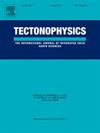堤防就位及其与断裂系统和区域应力场的相互作用:匈牙利Cserhát Hills的野外研究和地质年代学的结合
IF 2.6
3区 地球科学
Q2 GEOCHEMISTRY & GEOPHYSICS
引用次数: 0
摘要
在匈牙利中北部的Cserhát丘陵地区,在中新世中期发生了广泛的安山岩火山活动,有几个喷发中心。在此期间,该地区形成了广泛的堤坝系统,其中一些堤坝的最大长度为23公里,最大宽度为25米。该岩脉体系的走向由东西向北西—南西转变。在这里,我们整合了新的和以前的实地观察,得出了构造图,并研究了Cserhát山的岩脉和裂缝。通过K/Ar年代学研究,了解了岩脉形成前、形成中、形成后区域断裂模式的时间演化,以及岩脉侵位与区域应力场的相互作用。断层滑动数据收集于沿堤防的27个不同地点,并与距离堤防较远的16个地点的重新解释数据集相结合。野外观测与地质年代学资料表明,不同方位的岩脉位于15.4 Ma和14.7 Ma两个不同的喷发旋回中。潘诺尼亚盆地的变形史表现为区域最小应力轴的顺时针变化,这可能是区域垂直轴逆时针块体旋转的结果。我们的野外观察表明,走滑应力状态可能发生在扩展的岩脉尖端附近,最小应力轴的方向可能局部逆时针旋转,在那里岩脉改变了它们的走向,并沿着先前存在的裂缝(主要是正断层)放置。本文章由计算机程序翻译,如有差异,请以英文原文为准。
Dyke emplacement and its interaction with fracture systems and regional stress fields: Combination of a field study and geochronology in Cserhát Hills, Hungary
Widespread andesitic volcanism with several eruption centres occurred during the Middle Miocene in the Cserhát Hills, central – northern Hungary. In this time, an extensive dyke system developed in the area, where some dykes have exposed maximum length of 23 km, and maximum width of 25 m. This dyke system shows a change in its strike from E–W to NNW–SSE. Here we integrate new and previous field observations to derive structural maps and study dykes and fractures in the Cserhát Hills. K/Ar geochronology is used to understand the temporal evolution of regional fault patterns before, during and after the formation of the dykes and also to gain insights into the interaction between the dyke emplacement and the regional stress field. Fault-slip data were collected at 27 different sites along the dykes and were combined with reinterpreted datasets from 16 sites located at a distance from dykes. The field observations, integrated with the geochronological data sets suggests that dykes with different orientations were emplaced in two different eruptive cycles around 15.4 and 14.7 Ma. The deformation history of the Pannonian Basin involved a clockwise change in regional minimal stress axis, probably as a result of regional vertical–axis counter-clockwise block rotation. Our field observations suggest strike-slip stress regime may occur near propagating dyke tips, and the direction of minimal stress axis may have locally rotated counter-clockwise where dykes changed their strikes and emplaced along pre-existing fractures, mostly normal faults.
求助全文
通过发布文献求助,成功后即可免费获取论文全文。
去求助
来源期刊

Tectonophysics
地学-地球化学与地球物理
CiteScore
4.90
自引率
6.90%
发文量
300
审稿时长
6 months
期刊介绍:
The prime focus of Tectonophysics will be high-impact original research and reviews in the fields of kinematics, structure, composition, and dynamics of the solid arth at all scales. Tectonophysics particularly encourages submission of papers based on the integration of a multitude of geophysical, geological, geochemical, geodynamic, and geotectonic methods
 求助内容:
求助内容: 应助结果提醒方式:
应助结果提醒方式:


